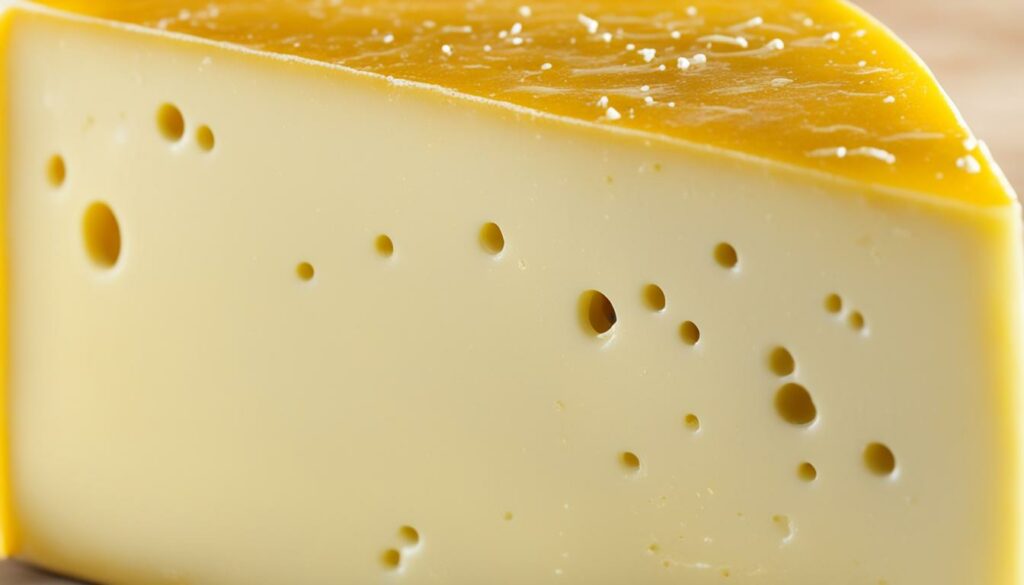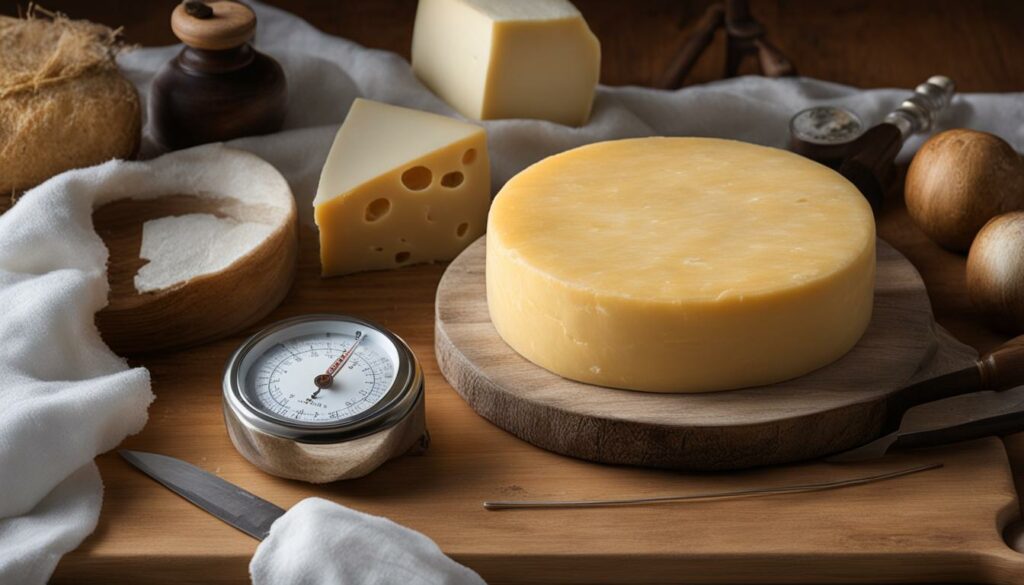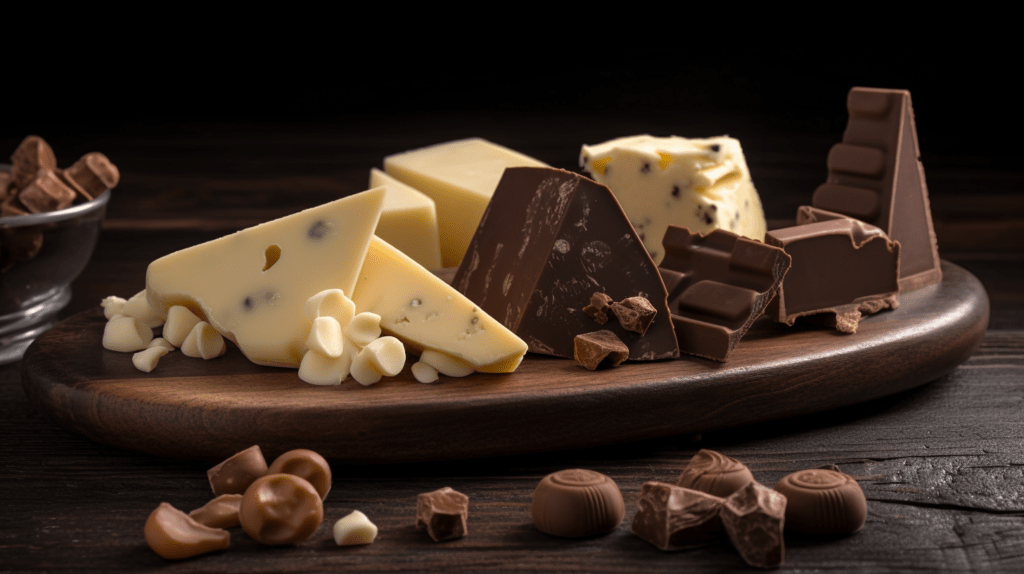Are you ready to indulge in the delicious world of Italian cheese? Look no further than Caciocavallo cheese – a true artisan delight that will elevate your culinary experience. This traditional semi-hard cheese, known for its pasta filata process, is a versatile ingredient that adds depth and flavor to a variety of dishes.
Whether you’re a cheese lover or a food enthusiast looking to explore new flavors, Caciocavallo cheese is a must-try. With its unique characteristics and aged qualities, it offers a one-of-a-kind taste that will tantalize your taste buds. From pasta recipes to cheese pairings, there are endless possibilities to create delightful meals with this Italian classic.
So, why wait? Let’s delve into the world of Caciocavallo cheese and discover the rich flavors, textures, and culinary potential it has to offer. Whether you’re an experienced chef or an amateur cook, this versatile Italian cheese is sure to impress.
The Story of Caciocavallo Cheese
Caciocavallo cheese has a fascinating history that traces back to the 14th century in southern Italy. This traditional Italian cheese has deep roots in the culinary heritage of the region and holds a special place in Italian cuisine.
Originally crafted by skilled cheesemakers in the Apennine Mountains of southern Italy, Caciocavallo cheese quickly gained popularity among locals for its unique flavor and excellent melting properties. The name “Caciocavallo” itself translates to “cheese on horseback,” which is derived from the way the cheese was hung over a wooden beam during the aging process, resembling a saddle.
“Caciocavallo cheese carries with it a rich history and is deeply intertwined with the cultural fabric of southern Italy.”
Italian immigrants eventually brought their love for Caciocavallo cheese to other countries, sharing this culinary gem with the world. This cheese quickly became a staple in Italian-American households as a testament to their culinary heritage.
Today, Caciocavallo cheese is still produced using traditional methods in its birthplace, southern Italy. The same time-tested techniques are employed by passionate cheesemakers who take pride in preserving the authenticity and legacy of this remarkable Italian cheese.
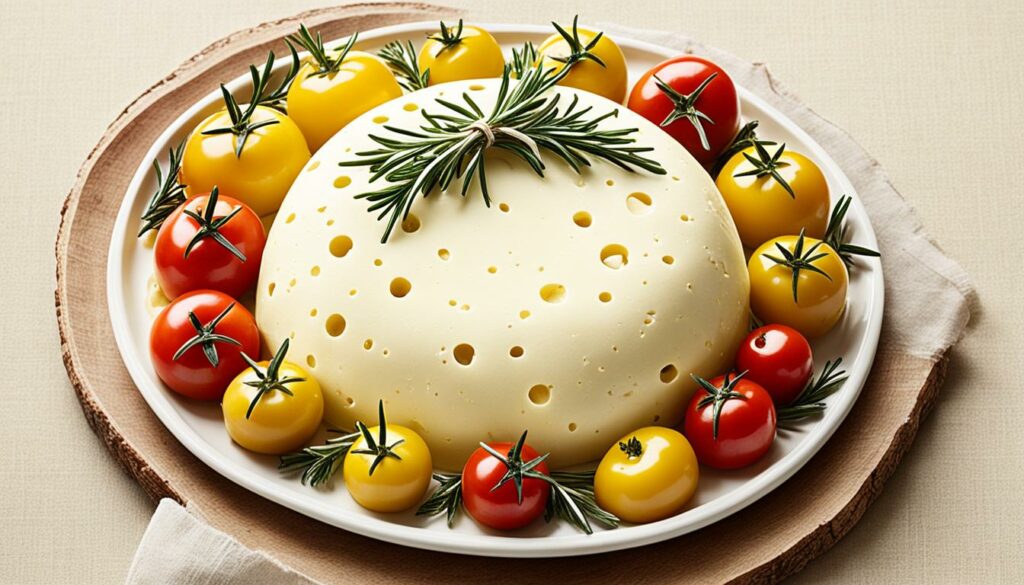
The Production Process of Caciocavallo Cheese
Producing Caciocavallo cheese involves a meticulous and skillful process that brings out its unique characteristics and flavors. Let’s take a closer look at the steps involved in crafting this delicious Italian cheese.
1. Milk Selection and Heating
The production begins with selecting high-quality milk, typically sourced from local farms. The milk is carefully heated to a specific temperature, creating the ideal environment for coagulation.
2. Coagulation with Starter Culture and Rennet
To initiate coagulation, a starter culture is added to the heated milk. This culture introduces bacteria that will contribute to the cheese’s flavor profile. Rennet, a natural enzyme, is also added to aid in the coagulation process.
3. Curd Formation and Pasta Filata
Once the milk has coagulated, the curds are cut into small pieces. These curds are then heated and stretched using a traditional pasta filata technique. This process gives Caciocavallo cheese its characteristic teardrop shape and smooth, elastic texture.
4. Aging and Curing
After shaping, the cheese is carefully aged and cured. This step is crucial as it allows the flavors to develop and mature over time. Caciocavallo cheese is typically aged for several months, during which it acquires a rich and savory taste.
Throughout the aging process, the cheese is carefully monitored and cared for by skilled cheesemakers. This attention to detail ensures that the final product meets the high standards expected of authentic Caciocavallo cheese.
Overall, the production process of Caciocavallo cheese showcases the dedication and expertise of southern Italian cheesemakers. Each step, from milk selection to curing, contributes to the creation of a truly delightful and unique cheese.
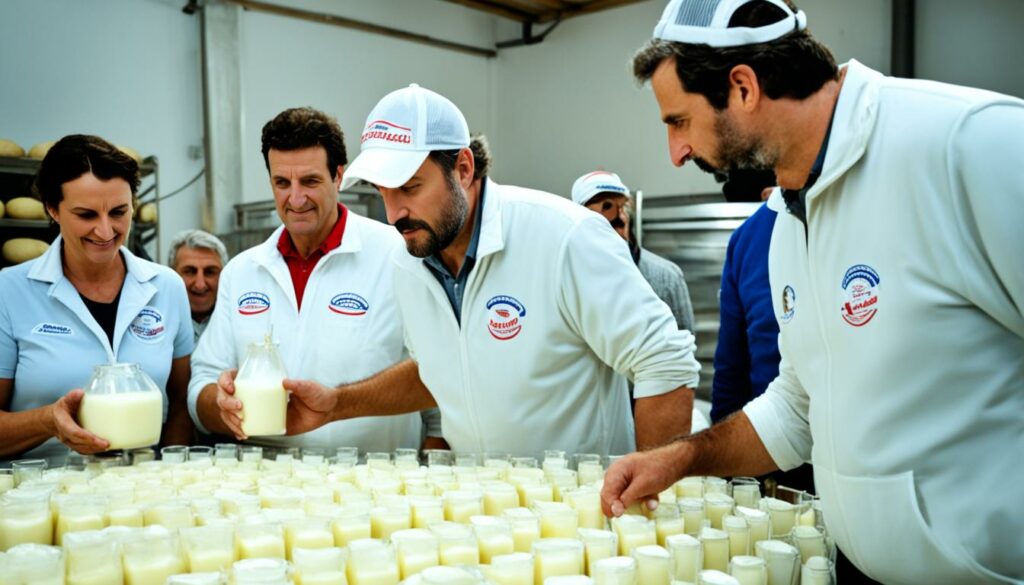
With a better understanding of the production process, you can truly appreciate the craftsmanship and artistry that goes into making Caciocavallo cheese. The next section will delve into the flavor profile and texture of this exquisite cheese.
Flavor Profile and Texture of Caciocavallo Cheese
Caciocavallo cheese, with its unique flavor profile and texture, is a delightful addition to any culinary experience. The taste of this Italian cheese evolves as it ages, offering a range of flavors that cater to different palates. When young, Caciocavallo cheese boasts a mild and slightly sweet taste with a subtle tanginess, creating a harmonious balance on the palate. As it matures, the cheese develops a stronger and more savory flavor, intensifying the experience for cheese enthusiasts.
The texture of Caciocavallo cheese is equally remarkable. Its smooth and elastic consistency is a result of the pasta filata process, where the curds are stretched and pulled to create its distinct shape. This texture adds a pleasing chewiness to the cheese, enhancing the overall sensory experience.
Whether enjoyed on its own, incorporated into recipes, or paired with other ingredients, Caciocavallo cheese offers a delightful combination of flavors and textures that appeal to a wide range of taste preferences.
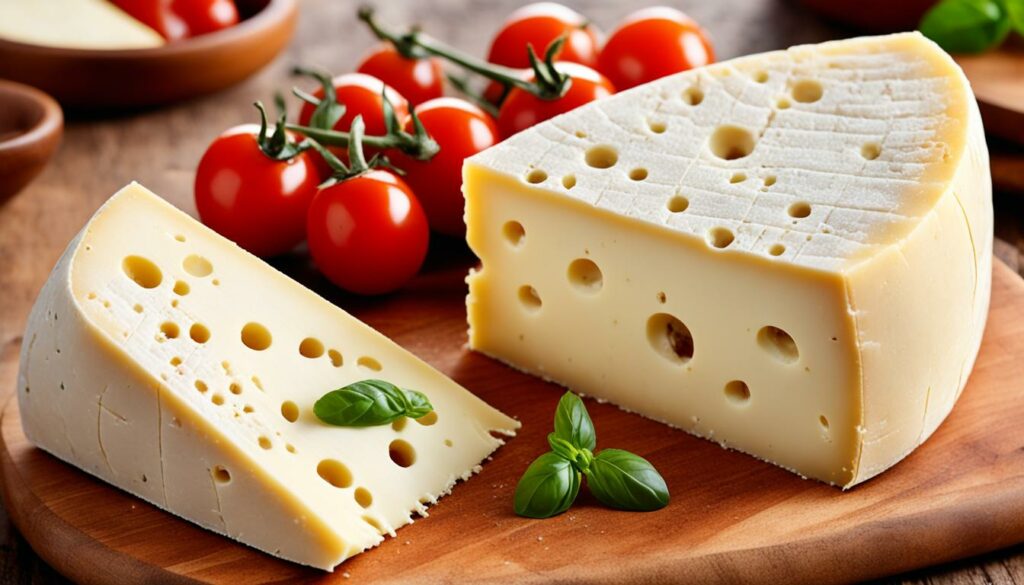
Culinary Uses and Pairings with Caciocavallo Cheese
Caciocavallo cheese is a versatile ingredient that can elevate your culinary creations. Whether you’re a fan of pasta dishes, pizza, grilled cheese sandwiches, or cheese platters, Caciocavallo cheese is the perfect addition to enhance the flavors of your favorite recipes. Its unique taste and smooth texture make it suitable for various culinary applications.
Popular Culinary Uses
- Pasta dishes: Incorporate Caciocavallo cheese into your pasta recipes for a creamy and indulgent twist. Its melting properties make it perfect for adding richness to pasta sauces.
- Pizza: Sprinkle grated Caciocavallo cheese over your homemade or store-bought pizza for a delightful cheesy topping. Its tangy flavor and meltability complement the other ingredients beautifully.
- Grilled cheese sandwiches: Elevate your classic grilled cheese sandwiches by using slices of Caciocavallo cheese. Its smooth and stretchy texture when melted creates a gooey and satisfying sandwich.
- Cheese platters: Create a delectable cheese platter with a variety of cheeses, including Caciocavallo. Its unique flavor profile adds diversity and sophistication to any cheese spread.
Perfect Pairings
Caciocavallo cheese pairs well with an array of ingredients, enhancing the overall flavor experience. Consider serving it with:
- Fruits: Pair Caciocavallo cheese with fresh or dried fruits like figs, grapes, or pears. The combination of sweet and savory flavors creates a delightful contrast.
- Cured meats: Enjoy Caciocavallo cheese alongside cured meats such as prosciutto, salami, or capocollo. The saltiness of the meats complements the cheese’s tanginess.
- Olives: Add a Mediterranean touch to your cheese and charcuterie platter by combining Caciocavallo cheese with a variety of olives, whether they are green, black, or stuffed with different fillings.
With its versatility and mouthwatering qualities, Caciocavallo cheese can transform ordinary dishes into extraordinary culinary experiences. Don’t miss out on the joy of incorporating this Italian delight into your cooking repertoire.
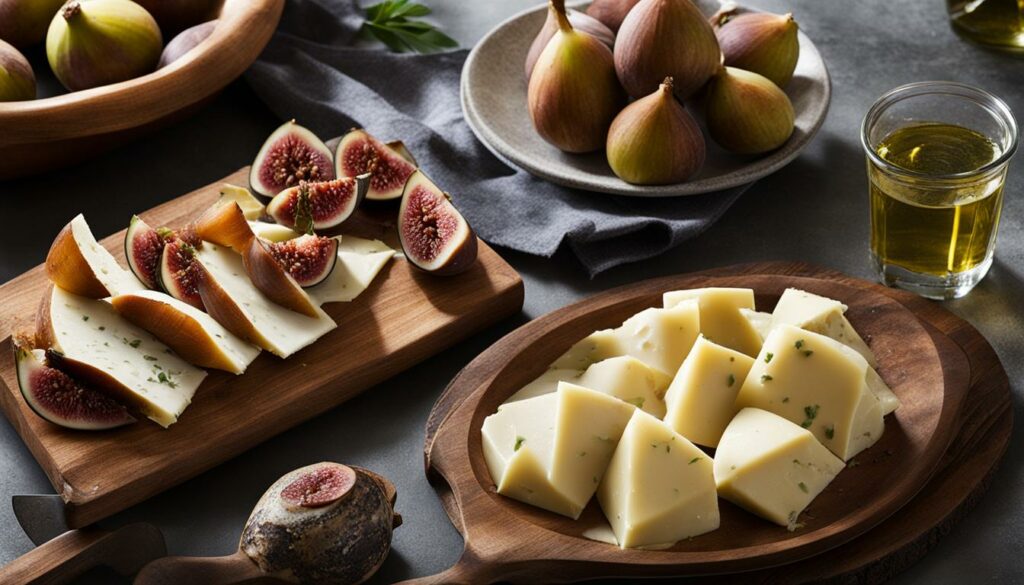
| Culinary Uses | Pairings |
|---|---|
| Pasta dishes | Fresh or dried fruits |
| Pizza | Cured meats |
| Grilled cheese sandwiches | Olives |
| Cheese platters |
Conclusion
Caciocavallo cheese is a true Italian delight that adds an authentic touch to any culinary experience. With its unique flavor and versatile uses, this Italian cheese is a must-try for both cheese connoisseurs and food enthusiasts. Whether you’re melting it over a piping hot pizza or grating it over a plate of pasta, Caciocavallo cheese brings a richness and depth of flavor that elevates your dishes to new heights.
One of the things that sets Caciocavallo cheese apart is its rich history and traditional production process. Dating back to the 14th century in southern Italy, this cheese has been crafted with skill and dedication for centuries. The pasta filata technique used in its production creates a smooth and elastic texture that enhances the overall culinary experience.
From classic Italian dishes to innovative recipes, Caciocavallo cheese offers endless possibilities in the kitchen. Its unique flavor adds a tangy and savory dimension to any dish, making it a versatile ingredient that pairs well with fruits, cured meats, and olives. Whether you’re hosting a dinner party or simply indulging in a cheese platter, Caciocavallo cheese is sure to impress.
So, why not explore the deliciousness of Caciocavallo cheese? With its rich history, distinctive flavor, and versatile uses, this Italian classic is a standout in the world of artisan cheeses. Take your culinary creations to the next level and savor the culinary experience that Caciocavallo cheese has to offer.
FAQ
What is Caciocavallo cheese?
Caciocavallo cheese is a delightful semi-hard cheese with Italian origins. It falls under the category of artisan and traditional cheeses and is known for its unique pasta filata process.
What is the history of Caciocavallo cheese?
Caciocavallo cheese has a rich history that dates back to the 14th century in southern Italy. It has become a staple in Italian cuisine and was also popular among Italian immigrants who brought it to other countries.
How is Caciocavallo cheese produced?
The production process of Caciocavallo cheese involves several steps. It starts with heating the milk and adding a starter culture and rennet to coagulate the milk. The curds are then cut, heated, and stretched to form the characteristic teardrop shape. The cheese is then aged and cured, which develops its flavor and texture.
What is the flavor profile and texture of Caciocavallo cheese?
When young, Caciocavallo cheese has a mild and slightly sweet taste with a hint of tang. As it ages, it becomes stronger and more savory. The texture of Caciocavallo cheese is smooth and elastic, thanks to its pasta filata process.
How can Caciocavallo cheese be used in cooking?
Caciocavallo cheese is a versatile ingredient that can be melted, grated, or sliced, making it suitable for a wide range of dishes. It can be used in pasta dishes, pizza, grilled cheese sandwiches, and cheese platters. It pairs well with fruits, cured meats, and olives.
Why should I try Caciocavallo cheese?
Caciocavallo cheese is a true Italian delight. With its unique flavor and versatile uses, it adds an authentic touch to any culinary experience. Its rich history, production process, and culinary potential make it a standout in the world of artisan cheeses.

